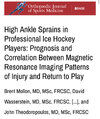I’ll take the study from these three medical professionals over someone on a hockey forum. Median of 8 games missed with roughly 20% missing no games
You're annoying me with your ignorance and arrogance at this point, so let me take you to school for a moment (as I'm a published researcher as well in this field).
I'm assuming you've read the abstract of the article and based your entire argument off of the following:
A total of 105 NHL athletes sustained high ankle sprains over the 5 seasons studied. Of these athletes, 85 were unable to play and missed a median of 8 games (range, 0-65 games). A retrospective MRI evaluation of 21 scans identified complete AITFL tears in 13 (62%) and high-grade partial tears in 5 (24%) cases. In contrast, the PITFL was partially torn in 9 (43%) and normal in 12 (57%) cases. Bone contusions were seen in 71% of cases and lacked a consistent pattern.
Now, should you actually know how to deciminate and read research, you'd know that reading the abstract of an article to base your entire argument is foolish at best and utterly ridiculous at worst. And here is no better perfect example.
If you actually read the article, they present a table of all the injuries that had MRIs to diagnose them (as was the purpose of the article looking at using MRI to better Dx High ankle sprains). This was the findings:
Table 1 Significance of MRI Findings on Return to Play After High Ankle Sprains
a
| Group | Return to Play, Mean ± SD, d | Significance |
|---|
| Based on degree of ligamentous injury | ANOVA: | |
| No/partial AITFL disruption | 38.2 ± 13.4 | SSq = 29.1; df = 17; F = 2.6; P = .238 |
| High-grade/complete AITFL disruption | 72.0 ± N/A | |
| Complete AITFL tear + 1 additional ligament injured | 38.4 ± 24.0 | |
| Complete AITFL tear + ≥2 ligaments injured | 42.0 ± 25.1 | |
| Based on presence of bone bruising | t test: | |
| Present | 42.1 ± 19.1 | t = 0.438; df = 19; P = .666 |
| Absent | 37.7 ± 25.0 | |
| Based on syndesmosis width | ANOVA: | |
| 2 mm | 36.0 ± N/A | SSq = 7.3; df = 17; F = 0.287; P = .961 |
| 3 mm | 47.5 ± 28.6 | |
| 4 mm | 40.3 ± 17.8 | |
| 5 mm | 36.8 ± 26.5 | |
aAITFL, anterior-inferior tibiofibular ligament; ANOVA, analysis of variance; MRI, magnetic resonance imaging; N/A, not available; SSq, sum of squares.
So simply looking off this, the median time to return from injury was at 38 days, with most reporting well over that.
When reading further as to the significance of this and why the MRI results are so much higher than the others, the others pointed to this limitation and flaw in their study:
Our trial does have limitations. As the NHL database allows for voluntary input from both physicians and trainers, it is possible that some injuries diagnosed as high ankle sprains were actually other abnormalities or that other players with a diagnosis of a high ankle sprain were not captured in this database.
The entire purpose of the study was to show the significance of using MRI to diagnose high ankle sprains and to better differentiate from low ankle sprains and other abnormalities in the ankle. The possibility for overdiagnosis without MRI imaging is significant relative to without it, hence the massive limitation.
If you're going to pull something as evidence, I would recommend reading the whole article versus just the first snippit you see. I'd also recommend you stay in your lane and stop trying to push your narrative because you don't know when to just say "hey, you're right. I didn't know that and that changes things. I appreciate the heads up or info." Instead, you keep doubling down and coming off worse each time.
Put down the shovel ffs.






